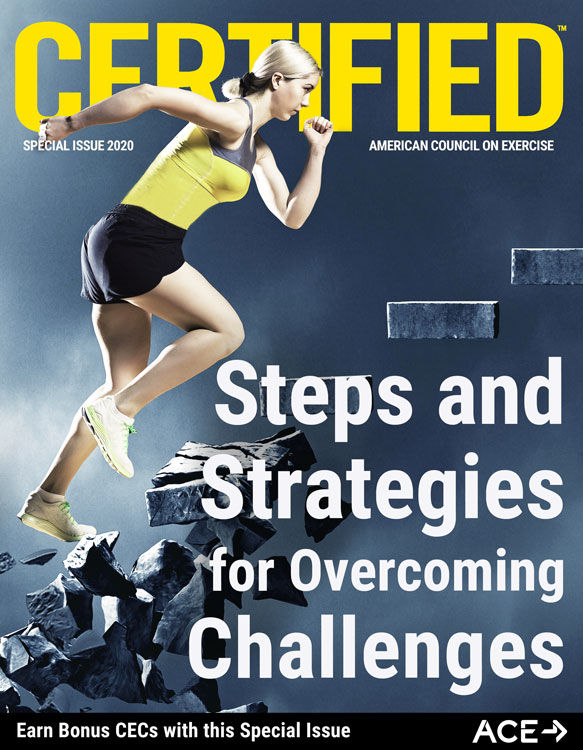
While some parts of the world are slowly emerging from the COVID-19 pandemic, others are still under strict limitations. Where I live in North Carolina, all fitness facilities remain closed. The same goes for movie theaters, bars, bowling alleys, museums and amusement parks. Restaurants can be open at 50% capacity, but many owners remain reluctant to offer dine-in service.
Couple all of that with various school districts and universities responding differently to the pandemic, and the boredom, loneliness and confusion many of my friends and neighbors are feeling is palpable.
A quick story: My wife and I recently ventured out to our first restaurant meal since mid-March. We sat in a booth, at a proper distance from other customers, but I quickly felt a level of anxiety that I had never experienced before. As I watched maskless waitstaff passing each other in tight spaces and talking over plates of food, and other customers laughing and chatting loudly, I was fidgety, sweaty and genuinely upset. What was supposed to be a nice break from the monotony of cooking at home was just plain stressful.
That experience made me realize just how stressed and anxious I had been without recognizing it. It had all been simmering just below the surface and that situation heightened my stress level to the point where I just couldn’t cope. That experience also got me thinking about how difficult all of this must be for people who battle depression and anxiety even during the best of times.
Of course, this is a very minor example of the types of things that are contributing to a nearly universal baseline level of stress that has permeated society. Much bigger issues are at play: managing a busy household where parents are working and kids are attending virtual school, lost jobs or income, reduced access to healthcare and, in an increasing number of cases, food insecurity.
The Impact of Chronic Stress
Ongoing stress contributes to the development and exacerbation of a number of physical and mental health conditions, including anxiety disorders, arthritis, asthma, cardiovascular disease, depression, stroke and certain types of cancer. Long-term changes and conditions that may develop, worsen or be impacted in some way as a result of the excessive and ongoing activation of the body’s stress response may include altered emotions, reproductive problems, increased risk of osteoporosis, increased insulin resistance, chronic inflammation, gastrointestinal issues, weight gain, memory impairment, cardiovascular dysfunction, chronic pain and headaches.
Not to pile on, but stress also plays a role in why people abandon their behavior-change plans, as it can lower self-efficacy, decrease motivation and negatively impact feelings of self-control.
So, to summarize, chronic stress makes just about everything worse, including our ability to manage the stress itself.
Depression, anxiety and fear are widespread, and many people are using negative coping mechanisms to fight their way through. This might include eating poorly, not exercising, or misusing or abusing alcohol or drugs. As a health and exercise professional, consider introducing your clients to the positive coping strategies presented here, and perhaps use a few of them yourself. No one is immune to the emotions tied to this pandemic, so be as kind to yourself as you are to your clients.

Jen Kates, CHC, NASM-CPT, is the founder of Shift Human Performance and an ACE Certified Health Coach. She says even some of her more resilient clients are feeling debilitated by the ongoing pandemic. They are experiencing anxiety and depression and are fearful of the unknown.
“They’re just not caring as much,” says Kates. “There is so much pain and anguish out there that people are finding it tough to focus on themselves.”
Carrie Myers, a certified mastery-level transformational coach with 30 years of experience in the fitness industry, sees this same pattern in her clients. In some cases, they are depressed, anxious, disappointed and even angry about the loss of their routines and social lives. These feelings, coupled with uncertainty, lead to a loss of motivation and a decreased ability to focus on their personal health and wellness.
Kates recommends shifting the conversation and empowering clients to show up for themselves, their family or society at large. Have your clients ask themselves, “Why is my health important to me?” Their answers may have shifted during the pandemic—and they may continue to shift over time—but this connection with the “why” is essential to long-term adherence.
“Clients should ensure that their values and behaviors are in alignment,” adds Myers. “If not, internal and external conflict can grow.” If those things are out of alignment, clients should think about why that is. Revisiting client values—and how physical activity and a healthy lifestyle promote those values—can help them focus on what’s important to them personally.

Goals should be an extension of a person’s values. And remember, people’s values may have shifted during this pandemic. You’ll likely find that clients are thinking more about their health—and their vulnerability to diseases like COVID-19. A client who was previously focused on weight loss and their ability to play basketball pain-free may now be thinking more about their overall health and the need to address their prediabetes before it progresses to diabetes.
You may also find that many clients are finding it tough to devote any time to physical activity, and it’s easy to see why. Working from home while homeschooling their kids; coping with the stress of unemployment or the death of a loved one; managing depression or other health issues—there is a seemingly endless list of things that may be a higher priority than getting outside for a walk or cooking a healthy meal. Getting through the day may be a victory on its own.
That said, small actions taken every day will add up over time, and, when it comes to physical activity, something is better than nothing. It’s O.K. if clients don’t have lofty performance goals or aggressive weight-loss objectives. Kates suggests asking clients, “How can you show up for yourself today?” In other words, what small thing can you do today to improve your physical and mental wellness?
Myers suggests that clients be mindful of how their behavior has changed during the pandemic and how they may be able to get back into their routines, or at least certain elements of them. A positive way to think about this, says Myers, is to ask, “How can I work to improve my health while staying within the boundaries and restrictions that currently exist?”

Remind clients that their weight does not define them. Nor does their athletic performance, caloric intake or number of steps. Health coaches and exercise professionals need to remember that unhealthy and fattening food can often be the most readily available coping mechanism available to their clients. There’s a reason they call it comfort food. Similarly, the TV and living room couch can have a powerful gravity when people are feeling overwhelmed with how much they have to accomplish or manage every day.
You’ll likely find that many of your clients have gained weight since this pandemic began in the spring. It’s essential that you remind them to be kind to themselves. It can be easy for clients to fall into a downward spiral of stress leading to overeating, leading to weight gain, leading back to additional stress, and so on.
Health coaches and exercise professionals must never judge or shame a client for gaining weight or falling off track—especially right now when so many people are vulnerable to that downward spiral. The last thing you want to do is give a client another reason to feel negative emotions. Your role is to come from a place of understanding and lift them up and empower them. Your clients likely need that now more than ever.

It can be tough in difficult times to feel grateful, but that is exactly when people need it most. Gratitude can boost feelings of well-being and actually improve a person’s health. Focusing on what you have, rather than what you have lost, allows you to regain a sense of control and balance. Myers recently wrote about gratitude for this publication and gave practical tips for how to coach your clients toward gratitude.

One simple thing that we can all do to improve not only our own health, but also the health of our friends and family members, is to reach out and connect. Kates reminds us that this is essential even if you think a particular person is strong or resilient and seems to be handling things well. It’s natural to want to check in on loved ones who are open and honest about their struggles, and to assume that those who are less vocal about their needs are doing just fine. That’s not always the case, and you may find that “strong” people genuinely appreciate the support, as they probably receive it so infrequently.
“Never downplay the importance of mental health,” says Kates. “Offer support and, just as importantly, accept help if you need it.”
This last point is vital, as many health coaches and exercise professionals are reluctant to admit their own struggles with their health, whether that comes in the form of weight gain, loss of motivation, depression or any of the other countless ways that stress can manifest in the body and mind. So be uplifting and empowering for your clients and loved ones, and then do the same for yourself. This pandemic has reminded us all that there are more important things than weight loss or athletic performance—and gratitude, community and kindness are certainly on that list.





 by
by 







